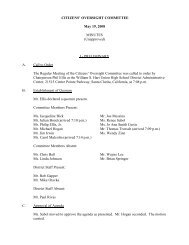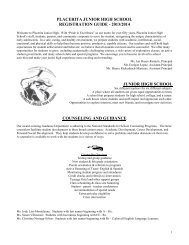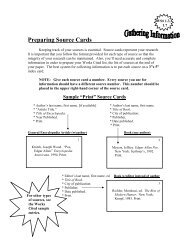Safe School Plan - William S. Hart Union High School District
Safe School Plan - William S. Hart Union High School District
Safe School Plan - William S. Hart Union High School District
You also want an ePaper? Increase the reach of your titles
YUMPU automatically turns print PDFs into web optimized ePapers that Google loves.
INCIDENT: WILDFIRE SMOKE*<br />
Composition of smoke<br />
Smoke is made up primarily of carbon dioxide, water vapor, carbon monoxide, particulate matter, hydrocarbons and other organics, nitrogen<br />
oxides and trace minerals. The composition of smoke varies with fuel type: different wood and vegetation are composed of varying amounts<br />
of cellulose, lignin, tannins and other polyphenolics, oils, fats, resins, waxes and starches which produce different compounds when burned.<br />
In general, particulate matter is the major pollutant of concern from wildfire smoke. Particulate is a general term for a mixture of solid<br />
particles and liquid droplets found in the air. Particulate from smoke tends to be very small (less than one micron in diameter) and, as a result,<br />
is more of a health concern than the coarser particles that typically make up road dust. Particulate matter from wood smoke has a size range<br />
near the wavelength of visible light (0.4 – 0.7 micrometers). This makes the particles excellent scatterers of light and, therefore, excellent<br />
reducers of visibility.<br />
Carbon monoxide is a colorless, odorless gas, produced as a product of incomplete combustion. It is produced in the largest amounts during<br />
the smoldering stages of the fire.<br />
Hazardous air pollutants are present in smoke, but in far less concentrations than particulate and carbon monoxide. The most common are<br />
acrolein, benzene and formaldehyde.<br />
Health effects of smoke<br />
The effects of smoke run from irritation of the eyes and respiratory tract to more serious disorders, including asthma, bronchitis, reduced lung<br />
function and premature death. Studies have found that fine particulate matter is linked (alone or with other pollutants) with a number of<br />
significant respiratory and cardiovascular-related effects, including increased mortality and aggravation of existing respiratory and<br />
cardiovascular disease. In addition, airborne particles are respiratory irritants, and laboratory studies show that high concentrations of<br />
particulate matter cause persistent cough, phlegm, wheezing and physical discomfort in breathing. Particulate matter can also alter the body’s<br />
immune system and affect removal of foreign materials from the lung, like pollen and bacteria.<br />
Carbon monoxide enters the bloodstream through the lungs and reduces oxygen delivery to the body’s organs and tissues. The health threat<br />
from lower levels of CO is most serious for those who suffer from cardiovascular disease. At higher levels, carbon monoxide exposure can<br />
cause headaches, dizziness, visual impairment, reduced work capacity, and reduced manual dexterity even in otherwise healthy individuals.<br />
At even higher levels (seldom associated solely with a fire), carbon monoxide can be deadly.<br />
People exposed to toxic air pollutants at sufficient concentrations and durations may have an increased chance of getting cancer or<br />
experiencing other serious health problems. However, in general, it is believed that the long term risk from toxic air pollutants from forest fire<br />
smoke is very low. Some components of smoke, such as many polycyclic aromatic hydrocarbons (PAH) are carcinogenic. Probably the most<br />
carcinogenic is benzo-a-pyrene (BaP), which has been demonstrated to increase in toxicity when mixed with carbon particulate. Other<br />
components, such as the aldehydes, are acute irritants. Three air toxics are of most concern from wildfires:<br />
1. Acrolein. An aldehyde with a piercing, choking odor. Even at low levels, acrolein can severely irritate the eyes and upper respiratory<br />
tract. Symptoms include stinging and tearing eyes, nausea and vomiting.<br />
2. Formaldehyde. Low level exposure can cause irritation of the eyes, nose and throat. <strong>High</strong>er levels cause irritation to spread to the<br />
lower respiratory tract. Long-term exposure is associated with nasal and nasopharyngeal cancer.<br />
3. Benzene. Benzene causes headaches, dizziness, nausea and breathing difficulties, and is a very potent carcinogen. Benzene causes<br />
anemia, liver and kidney damage, and cancer.<br />
Not everyone who is exposed to thick smoke will have health problems. Level, extent and duration of exposure, age, individual susceptibility<br />
and other factors play a significant role in determining whether or not someone will experience smoke-related health problems.<br />
Sensitive populations<br />
Most healthy adults will recover quickly from smoke exposures and will not suffer long-term consequences. However, certain sensitive<br />
populations may experience more severe acute and chronic symptoms from smoke exposure. Much of the information about how particulate<br />
affects these groups has come from studies done on urban particulate. More research is needed (and some of it is underway) to determine if<br />
particulate from wildfires affects these groups differently.<br />
Individuals with asthma, and other respiratory diseases: Levels of pollutants which may not interfere with normal breathing affect<br />
people with asthma in more profound ways, causing greater inflammation or constriction of airways.<br />
65

















